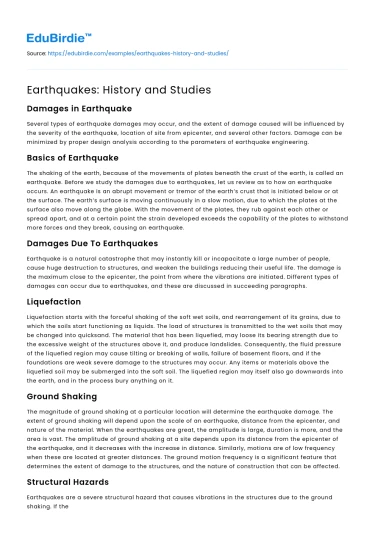Damages in Earthquake
Several types of earthquake damages may occur, and the extent of damage caused will be influenced by the severity of the earthquake, location of site from epicenter, and several other factors. Damage can be minimized by proper design analysis according to the parameters of earthquake engineering.
Basics of Earthquake
The shaking of the earth, because of the movements of plates beneath the crust of the earth, is called an earthquake. Before we study the damages due to earthquakes, let us review as to how an earthquake occurs. An earthquake is an abrupt movement or tremor of the earth’s crust that is initiated below or at the surface. The earth’s surface is moving continuously in a slow motion, due to which the plates at the surface also move along the globe. With the movement of the plates, they rub against each other or spread apart, and at a certain point the strain developed exceeds the capability of the plates to withstand more forces and they break, causing an earthquake.
Save your time!
We can take care of your essay
- Proper editing and formatting
- Free revision, title page, and bibliography
- Flexible prices and money-back guarantee
Damages Due To Earthquakes
Earthquake is a natural catastrophe that may instantly kill or incapacitate a large number of people, cause huge destruction to structures, and weaken the buildings reducing their useful life. The damage is the maximum close to the epicenter, the point from where the vibrations are initiated. Different types of damages can occur due to earthquakes, and these are discussed in succeeding paragraphs.
Liquefaction
Liquefaction starts with the forceful shaking of the soft wet soils, and rearrangement of its grains, due to which the soils start functioning as liquids. The load of structures is transmitted to the wet soils that may be changed into quicksand. The material that has been liquefied, may loose its bearing strength due to the excessive weight of the structures above it, and produce landslides. Consequently, the fluid pressure of the liquefied region may cause tilting or breaking of walls, failure of basement floors, and if the foundations are weak severe damage to the structures may occur. Any items or materials above the liquefied soil may be submerged into the soft soil. The liquefied region may itself also go downwards into the earth, and in the process bury anything on it.
Ground Shaking
The magnitude of ground shaking at a particular location will determine the earthquake damage. The extent of ground shaking will depend upon the scale of an earthquake, distance from the epicenter, and nature of the material. When the earthquakes are great, the amplitude is large, duration is more, and the area is vast. The amplitude of ground shaking at a site depends upon its distance from the epicenter of the earthquake, and it decreases with the increase in distance. Similarly, motions are of low frequency when these are located at greater distances. The ground motion frequency is a significant feature that determines the extent of damage to the structures, and the nature of construction that can be affected.
Structural Hazards
Earthquakes are a severe structural hazard that causes vibrations in the structures due to the ground shaking. If the structures are weak, or extremely rigid to withstand severe vibrations, then these may collapse. The tall buildings may experience extreme vibrations due to their height, and may fall down or into each other. Other destructive effects on structures due to an earthquake are sliding away from their foundations, and their horizontal or vertical movements that may make the structures unsafe.
Other Hazards
Other hazards that may cause earthquake damage include fire that can be started on the rupturing of power or gas lines, and severe losses may occur. In addition, bricks, rocks, trees may fall, sewage may enter water supplies and drinking of such water can cause serious diseases, and failure of transportation and means of communication may hinder rescue efforts. Furthermore, valuable records held by business concerns and governmental offices may be lost creating serious difficulties.
Preventive Measures
Preventive measures may reduce the destructive effects due to earthquakes, but may not completely eliminate the risk of damages. If a building is not properly designed to withstand earthquakes, it will be exposed to greater risks of structural damage. Suitable fixing of the structure with the foundation, and among the different constituents of the structure, is important for earthquake resistance. Structures that are not properly connected with the foundations may be shifted during an earthquake.






 Stuck on your essay?
Stuck on your essay?

